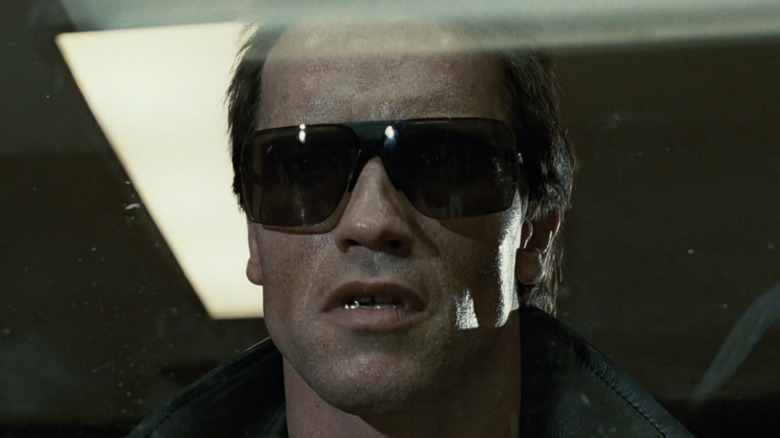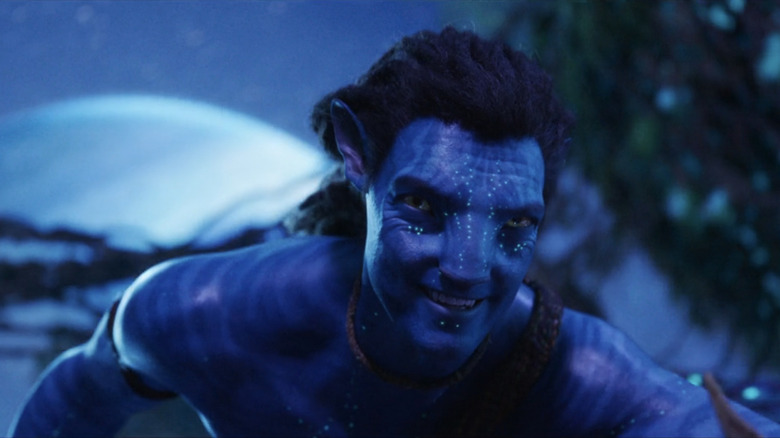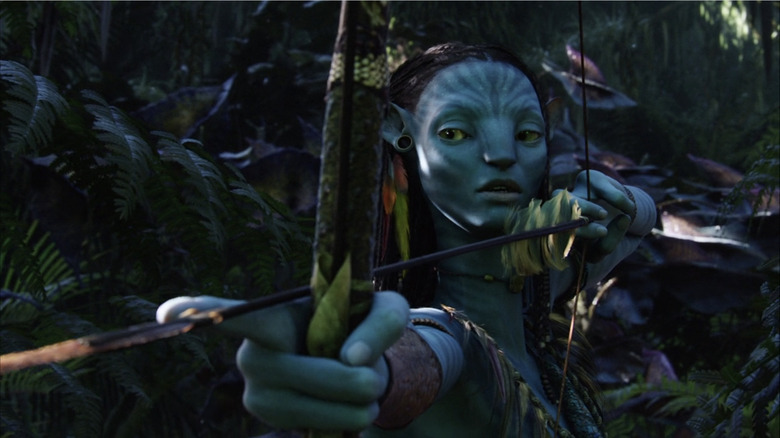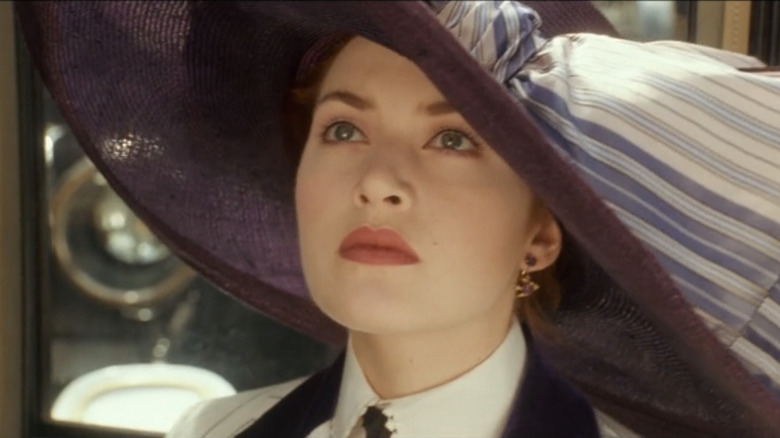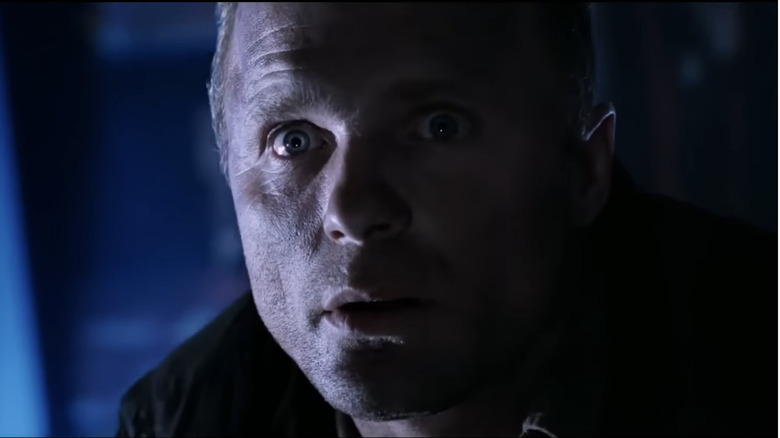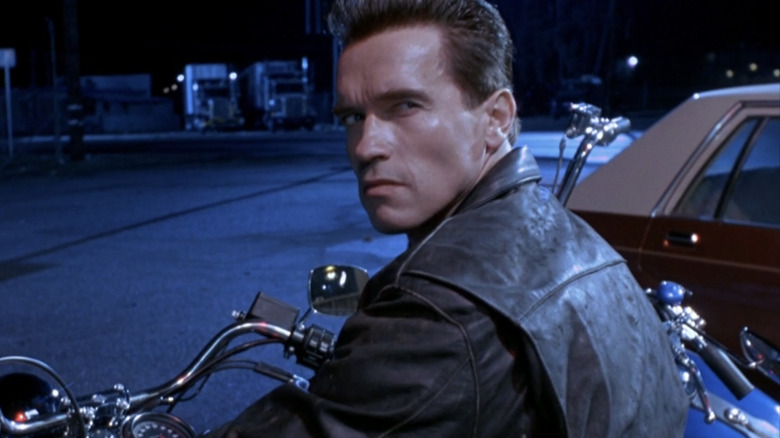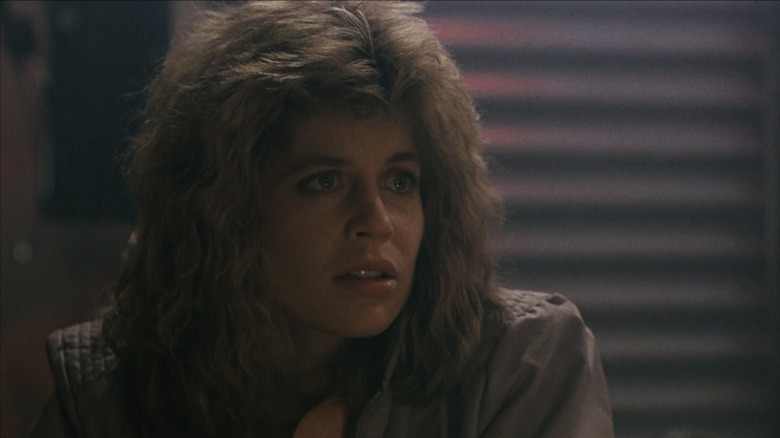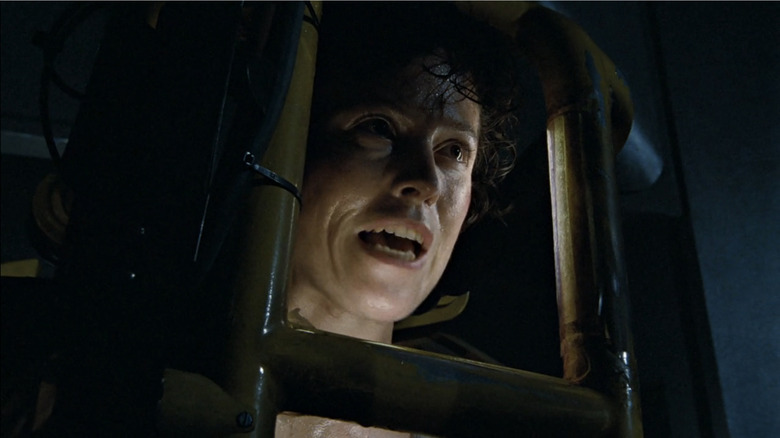Ranking Every James Cameron Movie From Worst To Best
The films of James Cameron are full of compelling contradictions. For decades he has been at the forefront of cinematic technology, yet his cutting-edge techniques are put to the service of old-fashioned (sometimes clichéd) storytelling. He's a bleeding heart liberal and peacenik, but is fascinated with military hardware and violence on screen. His films are personal and idiosyncratic, and sometimes downright weird, but have proven to be some of the most popular movies of all time.
From working art direction jobs for Roger Corman cheapies to helming the most expensive films in history, Cameron's career has followed a singular path. His films reach from the depths of the ocean to the farthest reaches of the cosmos, but what unites them is a humanity that transcends technology. Many of his most loved heroes are regular people who find themselves crushed (sometimes literally) under the gears of the machine age, whether they're doomed lovers aboard the world's greatest ship, a young woman who has no choice but to be humanity's only hope for the future, or a former space trucker whose greedy corporate bosses have unleashed a deadly parasite on the galaxy. Let's take a look at all of James Cameron's feature films, ranked from worst to best.
Piranha II: The Spawning
Reasonable people may debate the placement of the rest of the films on this list, but there's really no other candidate for "worst" than Cameron's directorial debut, 1981's "Piranha II: The Spawning." The original "Piranha" was released in 1978, part of a wave of cheap creature features that flooded theaters after the world-devouring success of "Jaws." Produced by B-movie maestro Roger Corman's New World Pictures, "Piranha" is an effectively nasty little horror-comedy, with two future auteurs writing and directing, respectively: John Sayles ("Brother From Another Planet," "Lone Star") and Joe Dante ("Gremlins," "The 'Burbs"). European schlockmeister Olivido Assonitis produced the sequel three years later, independent of Corman and New World, but utilizing a number of alums like screenwriter Charles Eglee and Cameron, who was hired as director but apparently fired two-and-a-half weeks in (per Terminator Files).
The plot of the film has little to no connection to the first "Piranha" other than the titular breed of deadly fish (who can fly this time around). It follows the "Jaws" template of an aquatic predator menacing a small tourist town whose leadership further endangers people by putting profits over safety. Unlike the first film, this one's reputation has not improved over the years, but if nothing else the experience introduced Cameron to some future collaborators: Eglee, with whom he would create "Dark Angel," the 2000 sci-fi series that introduced the world to Jessica Alba; and actor Lance Henricksen, here playing the Roy Scheider part of the town sheriff, who would work with Cameron on his next two films, "The Terminator" and "Aliens."
True Lies
1994's "True Lies" was a smash hit in the Summer of 1994, grossing nearly $300 million worldwide. Surprisingly, decades after its release, it's never been released on Blu-ray. There are any number of reasons why this could be. As Cameron — who has been consumed with "Avatar" and its potential sequels for the better part of 20 years — put it in a 2019 tweet, it's on his "to-do list." It could be that, being a 20th Century Fox release, there are distribution issues involving Fox's purchase by Disney in 2019 that have kept it out of circulation. It could also be because, while the film boasts some of Cameron's most audacious action scenes (and introduced most Americans to the Harrier jet), the rest of it is a very uncomfortable sit.
On paper, the plot is a comedy of remarriage. Suave superspy Harry Tasker (Arnold Schwarzenegger) is hit with two world-threatening crises at once: A Middle Eastern terrorist is planning to smuggle a nuclear warhead onto American soil, and Harry's unhappy wife Helen (Jamie Lee Curtis), who thinks he's a dorky computer salesman, is contemplating an affair with a sleazy used car salesman (Cameron muse Bill Paxton) who claims to be a secret agent. The terrorism plot traffics heavily in racial stereotypes, while the film takes a strange sort of glee in humiliating Helen (and by extension, Curtis) for daring to step outside of her marriage. And this isn't just a case of a film aging poorly; contemporary critics noted the retrograde racism and misogyny baked into its premise as well.
Avatar: The Way of Water
Cameron's first sequel (of a planned four) to 2009's "Avatar" was in production for so long that at least one of its actors assumed that the film had come out already and done poorly. Much like the original film, "Avatar: The Way of Water" arrived in theaters after years in the works and amid widespread skepticism that it would ever premiere at all. This is, for some reason, a common cycle for the director, as we'll see with the next two films on this list. Everyone seems ready to bet against James Cameron as he mounts his massive, seemingly doomed spectacles, only to once again discover that you don't bet against James Cameron.
"The Way of Water" catches up with former human Jake Sully (Sam Worthington), who is now fully immersed in his bionic alien avatar and living peacefully on the faraway moon Pandora with his wife Neytiri (Zoe Saldaña) and their children. But when an old nemesis previously thought dead (Stephen Lang) returns to seek revenge against Jake and the Na'vi, the family seeks protection from an oceanic tribe that is distrustful not just of the "sky people" invading from another planet, but of the Na'vi as well. The CGI-rendered world is undeniably gorgeous, vivid and colorful in an era when so many blockbusters are gray and muddy, but his reliance on high frame rate has proven controversial, as has his well-intentioned but problematic use of the Na'vi as a metaphor for Indigenous cultures (per Native News Online).
Avatar
"Titanic" became the highest-grossing film of all time against all expectations; certainly Cameron could not repeat the same trick twice. 12 years after "Titanic" broke the bank, though, he introduced the world to Pandora, the alien moon covered in lush greenery, floating mountains, and a giant, cat-like race of blue-skinned inhabitants known as the Na'vi. Pandora is also a rich source of a precious ore known as Unobtanium, which is of great interest to the United States military. To reach this motherlode, the military makes use of "avatars," bionic Na'vi bodies that are inhabited remotely by humans back on Earth. Paraplegic soldier Jake Sully (Sam Worthington) takes the assignment to infiltrate a Na'vi tribe in order to prepare for a full-scale invasion, but as he finds love, acceptance, and freedom in his Na'vi body, he starts to question his mission, and soon takes up arms against his former human comrades.
Buoyed by the upsell on 3D tickets (via CNN), "Avatar" unseated "Titanic" as the highest-grossing film of all time shortly after its 2009 release, eventually earning nearly $3 billion worldwide. As a spectacle, the film was unmatched, offering an entirely original vision of an alien world rendered almost entirely in photo-realistic CGI. As a story, however, it was derivative and often hokey, trafficking in pseudo-Native American mysticism and "white savior" tropes; even "South Park" noted that the plot was a rehash of "Dances with Wolves." Conservatives, meanwhile, dinged the film for being anti-military and anti-capitalist (per The Global Mail). Nevertheless, "Avatar" remains the biggest movie of all time; "Avengers: Endgame" briefly took the crown in 2019, but a 2021 re-release put "Avatar" back on top (via Deadline).
Titanic
Pivoting from the sour gender roles of "True Lies," Cameron's next film was a swooning, star-crossed love story set against the backdrop of perhaps the most famous disaster of the 20th century. "Titanic," a film about an act of colossal hubris, was itself an act of colossal hubris; the budget ballooned to over $200 million (the most expensive film ever made up to that point), and Cameron's famously demanding directorial style became a frequent target of pop culture parody. Everyone expected "Titanic" to fail; the symbolism was right there in the title. Instead, it spent an astonishing 15 weeks at number one at the box office and grossed $1.8 billion worldwide. The soundtrack album, led by Celine Dion's monster hit "My Heart will Go On," was the top selling album of 1998.
Cameron's trip aboard the world's biggest metaphor is an old-fashioned epic, with a cast of thousands, utilizing cutting edge CGI and gigantic physical sets to stage the great ship's terrifying demise in April of 1912. But while special effects inevitably age and lose their appeal, beautiful young people falling in love are timeless. Cameron wisely centers the film not around the systemic and human failures that led to the Titanic's sinking, but on the brief but powerful romance between penniless Jack (Leonardo DiCaprio), who won his 3rd class ticket in a card game, and high-born Rose (Kate Winslet), trapped in a loveless engagement to a wealthy magnate. DiCaprio and Winslet became instantly iconic, and a quarter century later, we're still arguing over whether or not Jack could have fit on that door.
The Abyss
Nestled between the sequels "Aliens" and "Terminator 2" is "The Abyss," an undersea thriller that's quietly revolutionary. On paper, it's pretty straightforward, if a little overstuffed — in many ways, it has more in common with the spirit of Ridley Scott's first "Alien" film than Cameron's actual sequel. A Navy SEAL (Michael Biehn, his third collaboration in a row with Cameron) conscripts a crew of working-stiff oil workers led by divorced couple Bud (Ed Harris) and Lindsey (Mary Elizabeth Mastrantonio) to recover a sunken submarine. The odds are stacked against them. Not only is a hurricane fast approaching, but the missing sub is carrying nearly 200 nuclear warheads — and since the accident happened off the coast of Cuba, it's possible that the Soviet military is responsible. But there are other forces at play, otherworldly elements that don't reveal themselves until the crew is too far gone to turn back.
Cameron manages an easy hangout vibe amongst the crew despite the script's heavy plot; Harris is naturally a standout, and Mastrantonio fits in well with Jeanette Goldstein, Sigourney Weaver, and Linda Hamilton in Cameron's pantheon of tough, capable women thriving in a man's world. But as strong as the film is on its own merits, it's arguably more important for what came after: Cameron's love of the sea would consume much of his time both on- and offscreen, and the experimental digital imagery that brought the "water tentacle" to life would bloom into the liquid metal menace of "Terminator 2."
Terminator 2: Judgment Day
As the last three decades of sequels, reboots, and more reboots have proven, it's hard to make a good "Terminator" movie. Even "Terminator 2: Judgment Day," far and away the best sequel and one of the best action films of all time, essentially reuses the same plot as the first film, pitting modern-day humans against a humanoid robot from the future in a film-length chase to stave off the apocalypse. Picking up about a decade after its predecessor, "Judgment Day" catches up with John Connor (Edward Furlong), the future savior of humanity, as a ten-year-old delinquent living in foster care. Meanwhile, his mother Sarah (Linda Hamilton) has transformed herself into a warrior-prophet of the coming nuclear holocaust, and is serving time in a mental hospital for her efforts. This time around, they must contend with two cyborgs sent back in time: an old-fashioned T-800 model (Arnold Schwarzenegger) reprogrammed to protect John, and the more advanced T-1000 (Robert Patrick), a deadly shape-shifter who adopts the guise of a friendly LAPD officer.
Beyond being a giant thrill ride of a film (and inspiring an actual thrill ride at Universal Studios), Cameron uses it to expound on his philosophical ideas about the dehumanizing nature of violence, seeing the cop disguise of the T-1000 and the increasingly unhinged Sarah as symbols of a society that doesn't value human life (via The Los Angeles Times). He also expands on the first film's tenet that the future is not set, as Sarah, John, and the T-800 work to not just survive the end of the world, but prevent it from actually happening.
The Terminator
"Terminator 2" was a massive success and set a bar for action films that is still in place decades later. It's huge in every way, but the first film, 1984's "The Terminator" — in many ways Cameron's true debut, more in line with his style than the debacle of "Piranha II" — is something different. It's a sleek, non-stop tech nightmare that makes up for its lack of resources with sheer intensity. In the near future, a war between mankind and super-advanced machines has come to an end with humanity victorious. In a last ditch effort, the machines send one of their own — a human-appearing cyborg known as a Terminator (Arnold Schwarzenegger) — back in time to murder the mother of human resistance leader John Connor before he's born. The resistance in response sends back one of their own, a soldier named Kyle Reese (Michael Biehn), to guard John's mother Sarah (Linda Hamilton) with his life.
There is a version of this movie where that set-up would take up the bulk of the running time; see 2015's "Terminator: Genisys." But here, all that future world gobbledygook is merely the gunshot that starts a frantic, 100-minute race through the slicked-down nighttime streets of 1984 Los Angeles. Exposition is parceled out as needed both to the audience and to the terrified Sarah, who at this point in her life is an aimless diner waitress. Hamilton and Biehn have great chemistry together, and their few tender moments help sell the film's time-bendy twist, but the show belongs to Schwarzenegger, who can't help but imbue an emotionless killer robot with movie star charisma.
Aliens
The 1981 Roger Corman production "Galaxy of Terror" is an obvious knock-off of Ridley Scott's "Alien" from 1979, but to watch it now, you might notice something curious. In tone and texture, it actually feels more like the sequel "Aliens," which wouldn't come out for another five years. This makes sense, however, when you learn that Cameron served as its art director, one of his last production gigs for the Corman B-movie machine before becoming a director full-time. But while "Galaxy of Terror," like the original "Alien," is focused on the trauma of sexual assault and insemination, Cameron's script for "Aliens" zeroes in on motherhood as its key theme.
Sigourney Weaver (in an Oscar-nominated performance) returns as Ellen Ripley, an interstellar heavy freight worker whose crew was decimated by a seemingly indestructible breed of alien. Adrift in her escape pod, Ripley awakens from suspended animation to find that nearly 60 years have passed since the events of "Alien," and to her horror, the moon where her crew found the deadly "xenomorph" now hosts a permanent human colony. When communications with the colony go down, Ripley accompanies a platoon of colonial Space Marines to investigate. There, they find a young girl who, like Ripley, is the lone human survivor of an attack, and a whole mess of aliens. Cameron trades in the haunted house atmosphere of the first film for high-caliber action, and his affection for his space grunts (played by Michael Biehn, Bill Paxton, Jeanette Goldstein, and others) is matched only by his disdain for the men who put them in harm's way (like Paul Reiser's corporate weasel). In the end, though, it all comes down to Ripley versus the Alien Queen, two badass mothers duking it out to protect their children.
